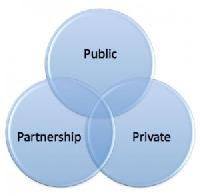
PPP is a mode of providing public infrastructure and services by Government in partnership with private sector. It is a long term arrangement between Government and private sector entity for provision of public utilities and services.
PPP mechanism is a major element of India’s infrastructure creation efforts as there is huge level of investment requirement in the sector. The twelfth plan targets to spend $1000 bn to expand infrastructure. Conventional form of finance – the budgetary allocation by the government is not enough to meet this big investment size. So the government at present is making several efforts to modify and energize the PPP (Public Private Partnership) mode of infrastructure generation. A committee chaired by Kelkar also made valuable recommendations to empower the PPP mechanism.
India’s experience with PPP in a serious manner started from 2006 onwards. PPP requires private sector participation in public asset creation through money, technology and management. For this, several models inviting thier participation were launched for different projects. Some of the commonly adopted forms of PPPs include build-operate-transfer (BOT) and its variants, build-lease-transfer (BLT), design-build-operate-transfer (DBFOT), operate-maintain-transfer (OMT), etc.
These models operate on different conditions on the private sector regarding level of investment, ownership control, risk sharing, technical collaboration, duration of the project, financing mode, tax treatment, management of cash flows etc. Following are the main models of PPPs.
(a) Build Operate and Transfer (BOT): This is the simple and conventional PPP model where the private partner is responsible to design, build, operate (during the contracted period) and transfer back the facility to the public sector. Role of the private sector partner is to bring the finance for the project and take the responsibility to construct and maintain it. In return, the public sector will allow it to collect revenue from the users. The national highway projects contracted out by NHAI under PPP mode is a major example for the BOT model.
(b) Build-Own-Operate (BOO): This is a variant of the BOT and the difference is that the ownership of the newly built facility will rest with the private party here.
The public sector partner agrees to ‘purchase’ the goods and services produced by the project on mutually agreed terms and conditions.
(c) Build-Own-Operate-Transfer (BOOT): This is also on the lines of BOT. After the negotiated period of time, the infrastructure asset is transferred to the government or to the private operator. This approach has been used for the development of highways and ports.
(d) Build-Operate-Lease-Transfer (BOLT): In this approach, the government gives a concession to a private entity to build a facility (and possibly design it as well), own the facility, lease the facility to the public sector and then at the end of the lease period transfer the ownership of the facility to the government.
(e) Lease-Develop-Operate (LDO): Here, the government or the public sector entity retains ownership of the newly created infrastructure facility and receives payments in terms of a lease agreement with the private promoter. This approach is mostly followed in the development of airport facilities.
(f) Rehabilitate-Operate-Transfer (ROT): Under this approach, the governments/local bodies allow private promoters to rehabilitate and operate a facility during a concession period. After the concession period, the project is transferred back to governments/local bodies.
(g) DBFO (Design, Build, Finance and Operate): In this model, the private party assumes the entire responsibility for the design, construction, finance, and operate the project for the period of concession.
(h) The private party assumes the entire responsibility for the design, construct, finance, and operate or operate and maintain the project for the period of concession.
(i) Management contract: Here, the private promoter has the responsibility for a full range of investment, operation and maintenance functions. He has the authority to make daily management decisions under a profit-sharing or fixed-fee arrangement.
(j) Service contract: This approach is less focused than the management contract. In this approach, the private promoter performs a particular operational or maintenance function for a fee over a specified period of time.
*********









